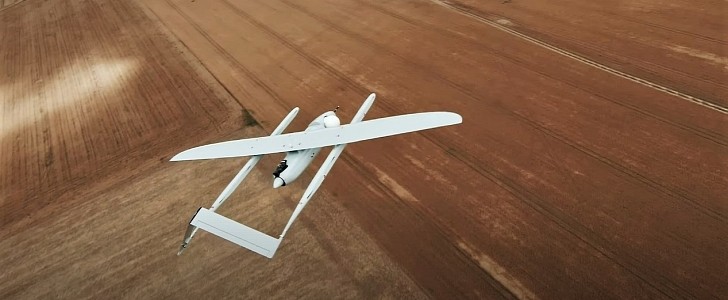We’ve seen plenty of new vertical takeoff and landing (VTOL) aircraft in the past that sport all sorts of new technologies to help them in flight. From contraptions that feature no wings to drones with massive propellers, there are many options to choose from when it comes to VTOLs. But this new aircraft from UAV Factory has something unique that allows it to hide its rotors for an increased flight endurance.
Recently, the manufacturer has introduced its new fixed-wing VTOL with Aeroflow Boom technology. Called Penguin C Mk2, the long-range unmanned aircraft is equipped with hoods that automatically hide the vertical lifting rotors when the vehicle is in horizontal flight, considerably lowering parasitic drag.
This allows the aircraft to fly for over 14 hours for distances of 110 miles (180 km) using batteries that can be replaced in under two minutes. Its booms are made of a carbon-fiber composite, which makes them light and durable. Even with the booms added, which allow it to operate in restrictive environments, the VTOL weighs only 70.6 lbs (32 kg).
It also comes with a 9.9 lb (4.5 kg) payload capacity and has a swappable nose design, which enables payloads to be swapped out in seconds. During emergency landings, the swappable nose features an integrated motor that adds roll stabilization and protects the payload. In addition, thanks to this design, the user can integrate custom payloads into the VTOL.
The aircraft comes standard with a Electro-Optical/Infra-Red (EO/IR) gyro-stabilized payload, which includes an MWIR thermal imager with 15x optical zoom and long-range 90x zoom, and a 4K camera. The user can also opt for other smaller EO/IR payloads, such as the Epsilon 140 series.
To date, Penguin C Mk2 has successfully completed over 600 takeoffs and landings in different environmental conditions. The aircraft can fly in 34 mph (54 kph) winds and operate in extreme temperatures that range from -40°C to +50°C (-40°F to 122 °F).
You can see the aircraft and its newly installed tech in action in the video down below.
This allows the aircraft to fly for over 14 hours for distances of 110 miles (180 km) using batteries that can be replaced in under two minutes. Its booms are made of a carbon-fiber composite, which makes them light and durable. Even with the booms added, which allow it to operate in restrictive environments, the VTOL weighs only 70.6 lbs (32 kg).
It also comes with a 9.9 lb (4.5 kg) payload capacity and has a swappable nose design, which enables payloads to be swapped out in seconds. During emergency landings, the swappable nose features an integrated motor that adds roll stabilization and protects the payload. In addition, thanks to this design, the user can integrate custom payloads into the VTOL.
The aircraft comes standard with a Electro-Optical/Infra-Red (EO/IR) gyro-stabilized payload, which includes an MWIR thermal imager with 15x optical zoom and long-range 90x zoom, and a 4K camera. The user can also opt for other smaller EO/IR payloads, such as the Epsilon 140 series.
To date, Penguin C Mk2 has successfully completed over 600 takeoffs and landings in different environmental conditions. The aircraft can fly in 34 mph (54 kph) winds and operate in extreme temperatures that range from -40°C to +50°C (-40°F to 122 °F).
You can see the aircraft and its newly installed tech in action in the video down below.









